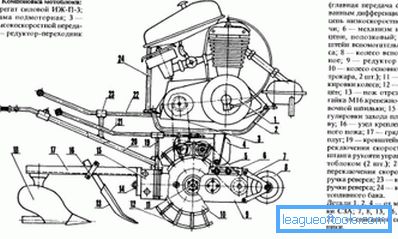The device of the modern motoblock
The motor-cultivator or the motor-block in recent times enjoys the increasing popularity among the population. This unit allows you to plow the land, transport cargo and perform several other functions. Manual labor with the tillers began to fade into the background. Now these devices are purchased by people, especially since they are not so expensive. It is important to know the device tiller. This will help in its further operation. This will be discussed today.

The layout of the motoblock.
Engine and its features
Everyone knows that any device that drives has a mandatory engine. It uses two main types of engines - diesel and gasoline. Both four-stroke engines and two-stroke engines are used. The second option is mainly distributed on the old motorblock. The work of operators is maximally simplified due to the automatic speed control method.
There are two main categories of such units - light and heavy. The power of the engines of the first options is from 1 to 5 horsepower. The second group is more powerful. Here this parameter can reach a value of 10 horsepower. There are, of course, more powerful models, but they are not so widespread, but you can buy them if necessary.

Engine circuit motoblock.
If we talk about the efficiency of the units, it is better today to buy a walk-behind tractor with a diesel engine. It will save money, due to the lower cost of fuel.
However, immediately it is worth thinking that in the process of work there will appear a mass of unpleasant smells from engine outlets. Which unit to choose, everyone decides for himself. Each option, of course, has its own advantages and disadvantages.
Back to table of contentsTransmission: characterizing performance
There are many different solutions of this node in the motoblock, namely, toothed, toothed-worm, belt-toothed-chain.
Gear transmissions. Such units are most often used in classic tractor technology. They have high reliability, but not the most compact size. Both bevel and cylindrical gears are used here.
Gear-worm transmissions. They are used mostly on lightweight units. A very simple device allows them to be repaired as easily. This transmission consists of two gearboxes - worm and gear. The crankshaft in this case is located in a vertical position. Most often they are set to automatic clutch.

Kinematic transmission scheme of the motoblock.
Quite a complex site, but very progressive and workable. Without automation today is nowhere. Yes, this sometimes makes the mechanisms much more complicated, but they make them much more efficient and productive. It should be noted that such transmissions are the most compact. They significantly reduce the volume of the motoblock, making it easy. In private home conditions such models have been used for a long time.
Belt and gear chain. The input shaft of the gearbox rotates due to a belt drive that connects it to the engine. It also serves as a clutch. Most often both gear, and a belt gear are carried out in the uniform case. In such models, the gear reducer can be either single-stage or two-stage. It all depends on the specific model of the motoblock. Most often, these parameters are indicated directly in the accompanying documentation for the unit.
Back to table of contentsAggregation system
This is another important component of the motoblock. It allows you to attach to it a variety of different units. If we talk about motor-cultivators, here the tools are mounted directly on the drive axle, and in motor-blocks they are mounted on a special bracket. Which method is more convenient? Of course, each person has his own opinion on this issue. On some units, a special power take-off system is installed.
Back to table of contentsControl system: main
Every happy owner of the tiller knows for sure that as a result of his work he has to walk on the ground. It does not allow to establish working governing bodies anywhere, except handles. It is here that manufacturers assemble the various elements of this system.
Usually the unit has special steering rods.
They will help the operator to easily manage the device, directing it in the right direction. On these steering rods, a variety of the most commonly used controls are necessarily located. We are talking about those mechanisms that allow you to adjust the speed of the engine and transmission.
Those controls that are used much less frequently are located on the units they control. This may be the control of the carburetor air damper, the inclusion of a power shaft, and so on. In general, everything should be clear about this issue. By the way, control is actually very simple on any motoblock. It uses not electronic, but mechanical elements, although in recent years the second option has become widely distributed in the market.
Of course, this greatly facilitates the work with the unit. Most often, management is like an ordinary motorcycle. For those who know what they are talking about, they understand that there is a clutch on the left hand grip and engine controls on the right.
Everything after a long period of work goes to a simple intuitive level. At first, it may be difficult to work with such a powerful technique, but over time a person will get used to it. It can be noted that the productivity of such labor is much higher than manual labor.
So, now everyone knows the basic elements of a modern motoblock. Today, such equipment can be purchased at any specialty store. Knowing his device, you can independently carry out and repair it, and this is important. Breakdowns can occur regularly during operation, and too frequent visits to workshops lead to unforeseen costs.